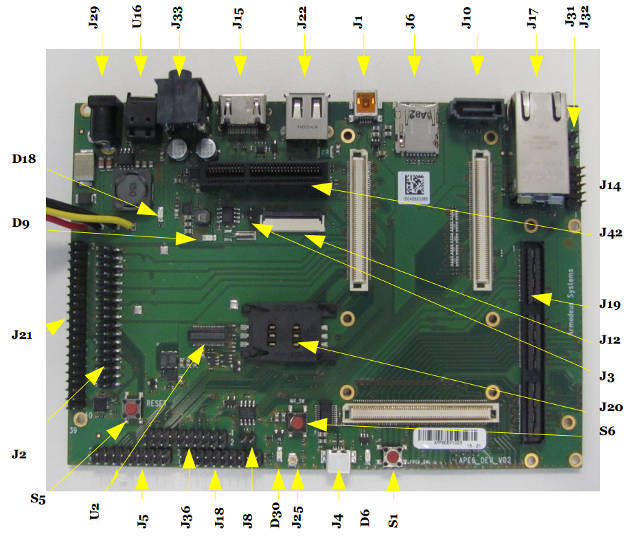APF6Dev: Difference between revisions
From ArmadeusWiki
(→Linux) |
|||
| (9 intermediate revisions by the same user not shown) | |||
| Line 38: | Line 38: | ||
|| | || | ||
===User Input=== | ===User Input=== | ||
* [[Tslib|Touchscreen]] | * [[Tslib|Touchscreen]] (SX8654) | ||
===Wired communication=== | ===Wired communication=== | ||
| Line 76: | Line 76: | ||
==Connectors== | ==Connectors== | ||
[[File:APF6Dev.jpeg]] | {| cellpadding="5" cellspacing="0" | ||
|- | |||
[[File:APF6Dev.jpeg| align=left]] | |||
|| | |||
{| border="1" cellpadding="5" cellspacing="0" summary="APF6Dev connectors" | |||
|- style="background:#efefef;" align="center" | |||
! Name !! Function | |||
|- align="center" | |||
| J17 || Gigabit Ethernet | |||
|- align="center" | |||
| J15 || HDMI | |||
|- align="center" | |||
| J33 || Audio (Out/Up, In/Down) | |||
|- align="center" | |||
| J29 || Power (12V) | |||
|- align="center" | |||
| J36 || JTAG | |||
|- align="center" | |||
| J5 || Extension 1 | |||
|- align="center" | |||
| J18 || Extension 2 | |||
|} | |||
|} | |||
==Tips== | ==Tips== | ||
| Line 120: | Line 146: | ||
<pre class="apf"> | <pre class="apf"> | ||
BIOS> mw.l 0x020b4000 0x00000f04 (clear bit 12) | BIOS> mw.l 0x020b4000 0x00000f04 (clear bit 12) | ||
</pre> | |||
* Use APF6Dev "User" Button (GPIO Port 1 Pin 9) in U-Boot scripts: | |||
If you have a recent U-Boot, supporting ''gpio'' command: | |||
<pre class="apf"> | |||
BIOS> setenv user_button 'gpio input 204' | |||
BIOS> if run user_button; then echo "Button pressed"; fi | |||
gpio: pin 9 (gpio 9) value is 0 (if pressed) | |||
Button pressed | |||
</pre> | |||
Otherwise, you can do it 'the old way': | |||
<pre class="apf"> | |||
BIOS> setenv user_button 'setexpr.l toto *0x0209c000 \\& 0x200; if itest ${toto} -eq 0; then true; else false; fi' | |||
BIOS> if run user_button; then echo "Button pressed"; fi | |||
</pre> | |||
* Detect USB OTG cable presence: | |||
<pre class="apf"> | |||
BIOS> setenv usb_cable 'setexpr.l toto *0x020c81c0 \\& 0xf; if itest ${toto} -eq 0xe; then true; else false; fi' | |||
BIOS> if run usb_cable; then echo "USB detected"; fi | |||
</pre> | </pre> | ||
===Linux=== | ===Linux=== | ||
* to activate login in Framebuffer console, please uncomment ''/etc/inittab'' line 35 this way: | * to activate login in Framebuffer console, please uncomment (or add) ''/etc/inittab'' line 35 this way: | ||
<pre class="apf"> | <pre class="apf"> | ||
# Set up a getty on LCD | # Set up a getty on LCD | ||
Latest revision as of 13:48, 20 January 2023
Description
This is the Armadeus System's standard development board/baseboard for the APF6 module.
The following options are available:
Errata
- As the board is also used for APF6_SP module (APF6+FPGA), you might experience some miscellaneous FPGA LED blinking (beside "FPGA_SW" button) when no FPGA is present.
Resources
Feature list
Audio
Video Out
Video In |
User Input
Wired communicationStorage |
Realtime clockWireless communicationFPGA connectionsOther |
Connectors

|
Tips
U-Boot
- To use 7" 800x480 LCD with 3.10/3.14/4.1 legacy kernels:
BIOS> setenv extrabootargs video=mxcfb0:dev=lcd,800x480@60,if=RGB666,bpp=32
then, after having booted Linux, do:
root@apf6 ~ # fbset > /etc/fb.modes
- Activating HDMI console with USB keyboard in U-Boot (since armadeus-6.0):
BIOS> usb start BIOS> setenv stdout serial,vga BIOS> setenv stderr serial,vga BIOS> setenv stdin serial,usbkbd
keyboard map is english one and it seems not possible to change it (U-Boot 2014.07) ?
- Use APF6Dev "User" LED in U-Boot scripts:
If you have a recent U-Boot, supporting gpio command:
BIOS> gpio set 204 ... BIOS> gpio clear 204
Otherwise, you can do it 'the old way'; declare GPIO Port 7 Pin 12 (connected to the LED) as GPIO:
BIOS> md.l 0x020b4004 1 020b4004: 00000100 BIOS> mw.l 0x020b4004 0x00001100 (set bit 12)
Switch LED on:
BIOS> md.l 0x020b4000 1 020b4000: 00000f04 BIOS> mw.l 0x020b4000 0x00001f04 (set bit 12)
Switch LED off:
BIOS> mw.l 0x020b4000 0x00000f04 (clear bit 12)
- Use APF6Dev "User" Button (GPIO Port 1 Pin 9) in U-Boot scripts:
If you have a recent U-Boot, supporting gpio command:
BIOS> setenv user_button 'gpio input 204' BIOS> if run user_button; then echo "Button pressed"; fi gpio: pin 9 (gpio 9) value is 0 (if pressed) Button pressed
Otherwise, you can do it 'the old way':
BIOS> setenv user_button 'setexpr.l toto *0x0209c000 \\& 0x200; if itest ${toto} -eq 0; then true; else false; fi'
BIOS> if run user_button; then echo "Button pressed"; fi
- Detect USB OTG cable presence:
BIOS> setenv usb_cable 'setexpr.l toto *0x020c81c0 \\& 0xf; if itest ${toto} -eq 0xe; then true; else false; fi'
BIOS> if run usb_cable; then echo "USB detected"; fi
Linux
- to activate login in Framebuffer console, please uncomment (or add) /etc/inittab line 35 this way:
# Set up a getty on LCD tty1::respawn:/sbin/getty 38400 tty1